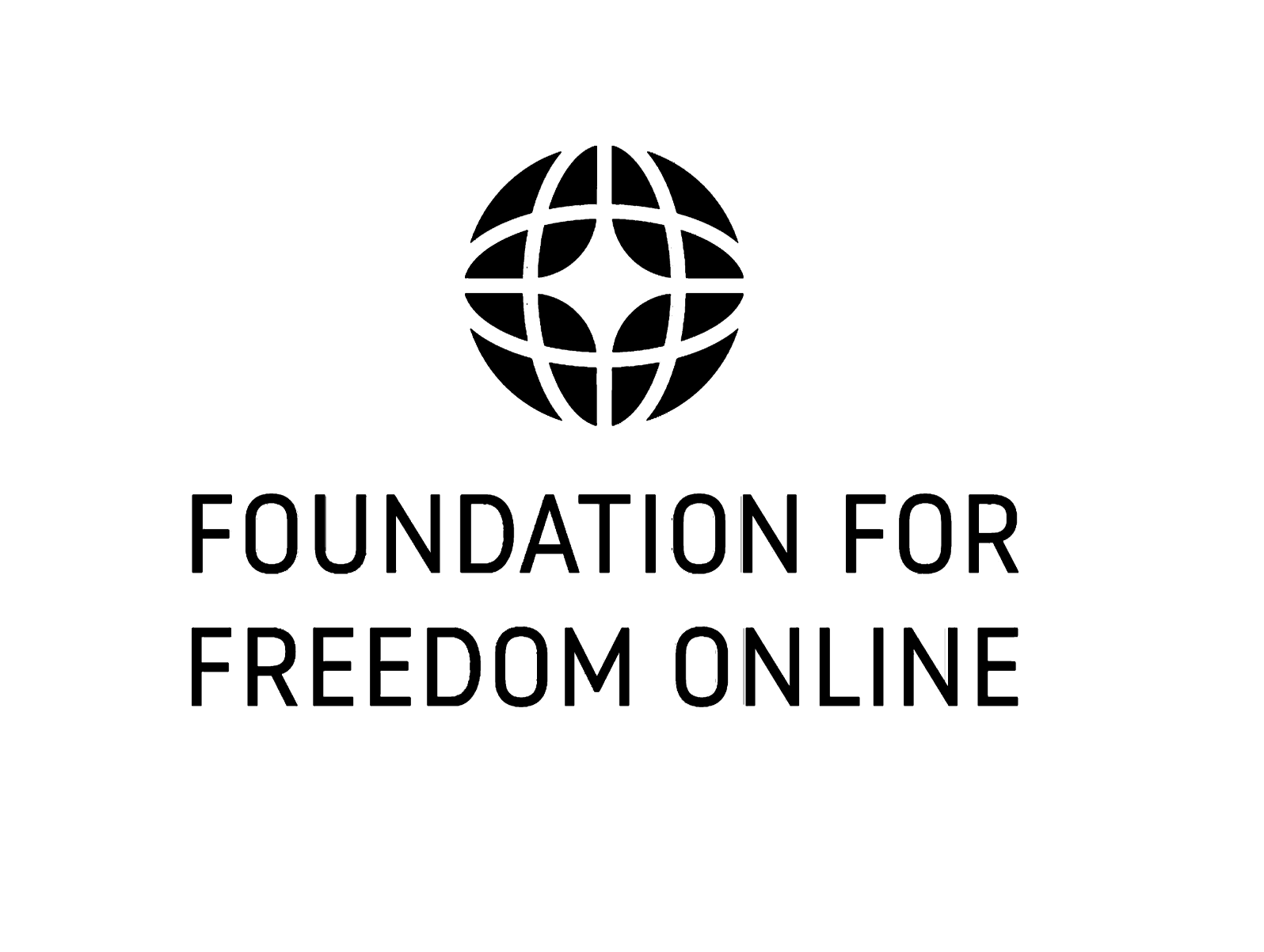SUMMARY
- White House publications from 2022 shows that under the previous administration, the Federal government attempted to coordinate the global “counter-disinformation” industry, in an effort that spanned private and public sectors and traveled across borders.
- These efforts materialized in a White House-led interagency working group on “Information Integrity Research and Development,” overseen by the White House Office of Science and Technology Policy (OSTP).
- In the words of the White House, the goal was to mobilize “government employees, policymakers, researchers, entrepreneurs, businesses, individuals, communities, nonprofit organizations, libraries, museums, other educational institutions, and foreign partners” to combat disfavored online information.
- This coincided with the rise of a common trope among “disinformation researchers” — that the response to disfavored information should be a “whole-of-society” approach, including the public, private and nonprofit sectors.
- The document shows the Biden White House officially endorsed the pro-censorship, anti-First Amendment view that the concept of a “marketplace of ideas” is outdated, calling it an “idealized notion.”
- While little information about its work has been made public since 2022, the Information Integrity working group remains in operation, per White House reports.
The new administration has passed an executive order officially ending the Federal government’s support for online censorship. This is a major break from the past, since the outgoing administration went further than any other in its efforts to capacity-build a world-spanning regime of online information control.
Between 2021 and the end of 2022, President Biden’s White House assembled a sprawling mix of government agencies, nonprofits, and private sector allies in what it termed the “whole-of-society” approach to combat “disinformation.” This is the web that the new administration, if it holds true to its free speech promises, will have to unravel.
In December 2021, the White House issued a press release titled “The Biden-Harris Administration is Taking Action to Restore and Strengthen American Democracy.” Included in the press release was the White House’s plans to “combat misinformation and disinformation,” which involved the creation of an interagency working group for “Information Integrity Research and Development.”
A year later, in December 2022, the working group published its first report, titled “Roadmap for Researchers on Priorities Related to Information Integrity Research and Development.”
The document was issued directly from the Executive Office of the President, overseen by the White House Office of Science and Technology Policy (OSTP), more specifically the National Science and Technology Council’s Networking and Information Technology Research and Development Subcommittee (NITRD).
In total, 26 federal agencies and offices, 14 universities, and over 20 nonprofit/private sector groups and individuals, many of which are well-documented online censorship coordinators, offered nsights and contributions to the working group’s efforts.
Among the 26 federal agencies was USAID:
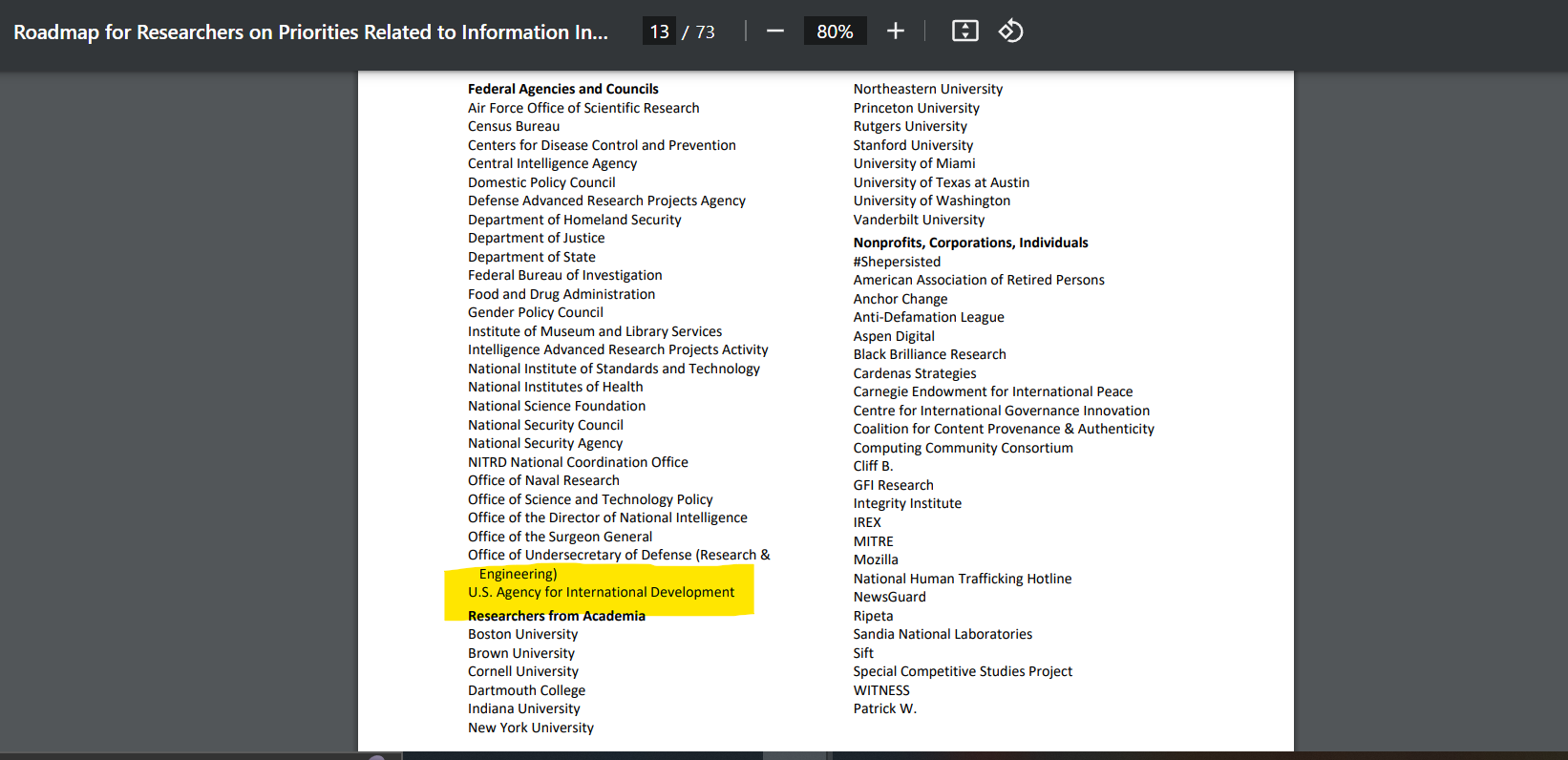
In the months leading up to President Trump’s second inauguration, the White House seemed to be taking measures to hide their censorship coordination. White House budget supplementation documents confirm the IIRD IWG was selected to continue into FY 2025. The “Information Integrity” effort, however, is the only working group out of 11 that is not listed on the NITRD website. The IIRD IWG webpage, which provided specific information like the current co-chairs of the group, vanished off the internet during the drafting of this report, only retrieved by FFO via the Wayback Machine Archive.
In December 2021, when the working group was first developed, the federal government’s intelligence and technological development coordination arms played a large role in operating the working group. Robert Lawton, Chief of Mission Capabilities in the Office of the Director of National Intelligence (ODNI), Suresh Venkatasubramanian, Assistant Director of the White House Office of Science and Technology Policy (OSTP) co-chaired the group along with Nina Amla, Program Director at the National Science Foundation (NSF).
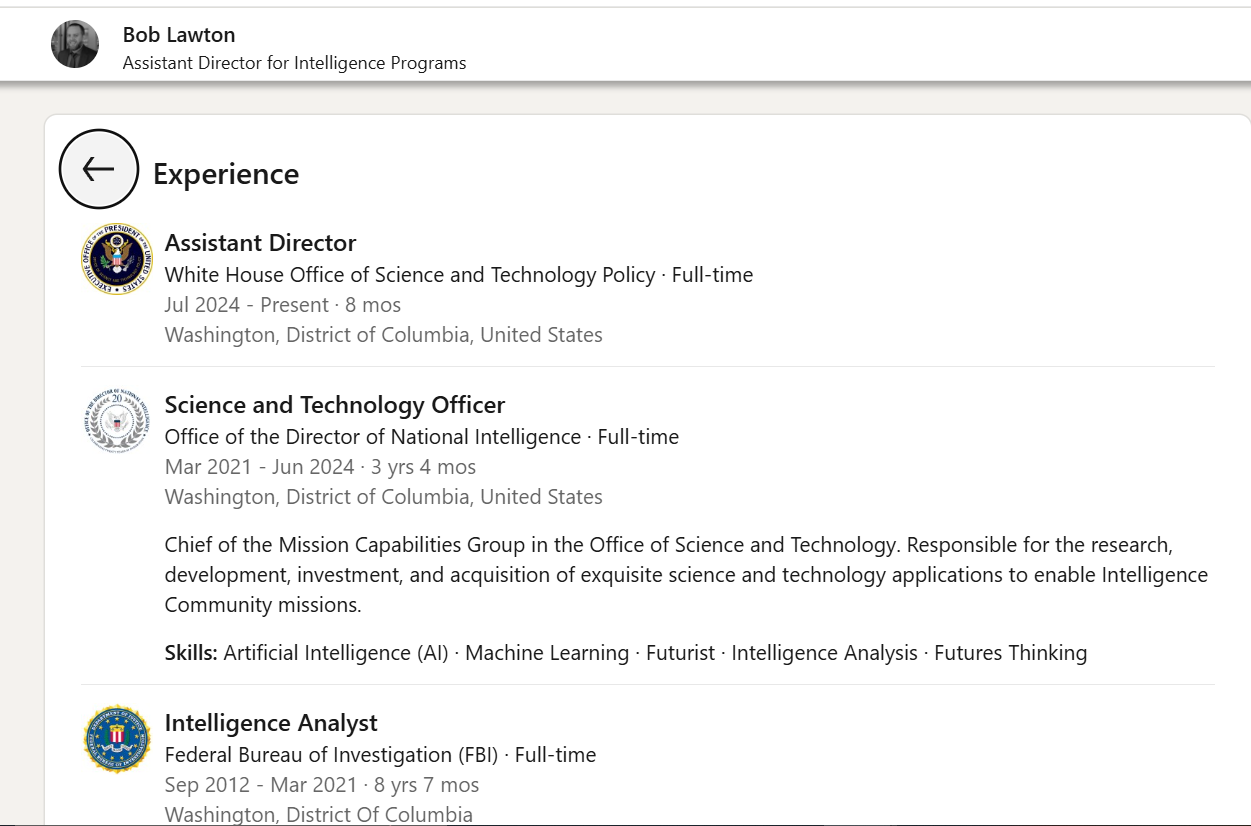
According to his LinkedIn, Lawton worked at the Defense Intelligence Agency and the FBI before joining ODNI. In July 2024, he moved to the White House, becoming Assistant Director at OSTP, the very same White House office that coordinated information integrity efforts.
Whole-of-Society
Censorship industry insiders in the U.S. government and its partners in academic institutions, private-sector firms, and civil society organizations have long framed the problem of so-called “mis-, dis- and malinformation” as a “whole-of-society problem” that requires a whole-of-society response.
The unification of federal agencies and third-party private sector allies around the “whole of society” concept was anything but organic. The establishment of the Information Integrity working group in the first year of the outgoing administration
While this response may seem to have come organically across federal agencies and the private sector, the Information Integrity working group’s report suggests the approach was highly coordinated and unified under the aegis of the White House in 2021-22.
The Information Integrity working group’s roadmap document identifies roles for government, private sector, nonprofits/think tanks, civil society organizations, individual citizens, and the need for public-private coordination on the effort.
Indeed, the the roadmap states openly that its purpose is to provide a framework for “government employees, policymakers, researchers, entrepreneurs, businesses, individuals, communities, nonprofit organizations, libraries, museums, other educational institutions, and foreign partners” to ensure they can “provide meaningful safeguards around information integrity.”
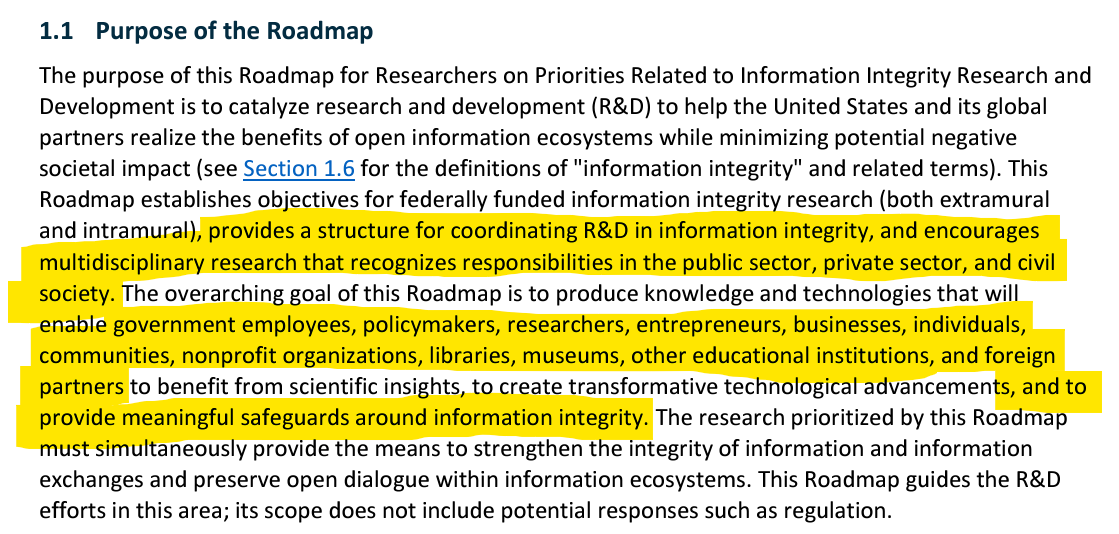
On page seven of the report, the working group states that one of its goals is to “inspire parallel efforts in the private sector.”
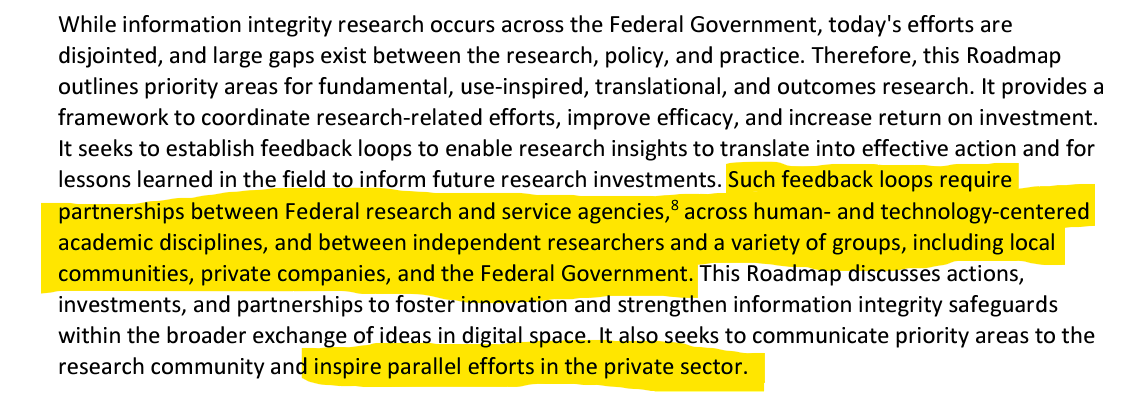
The White House also sought to direct the vast network of information integrity “researchers” in the private sector, who play a key role in identifying targets for online censorship and pressuring social media platforms to comply.
From page six:
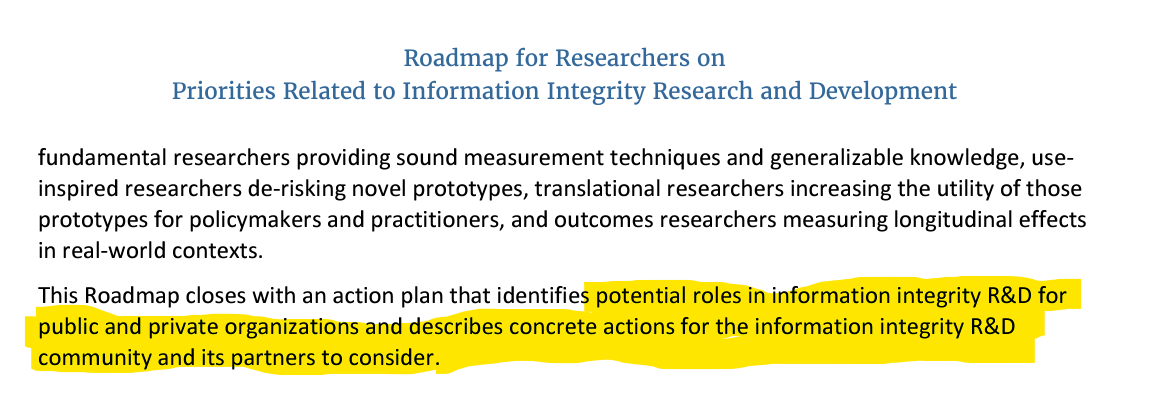
The report also stresses the need for tech companies to grant free, privileged access to those same online censors in the academic community — access that was quickly revoked by X shortly after Elon Musk’s takeover.
From page five:
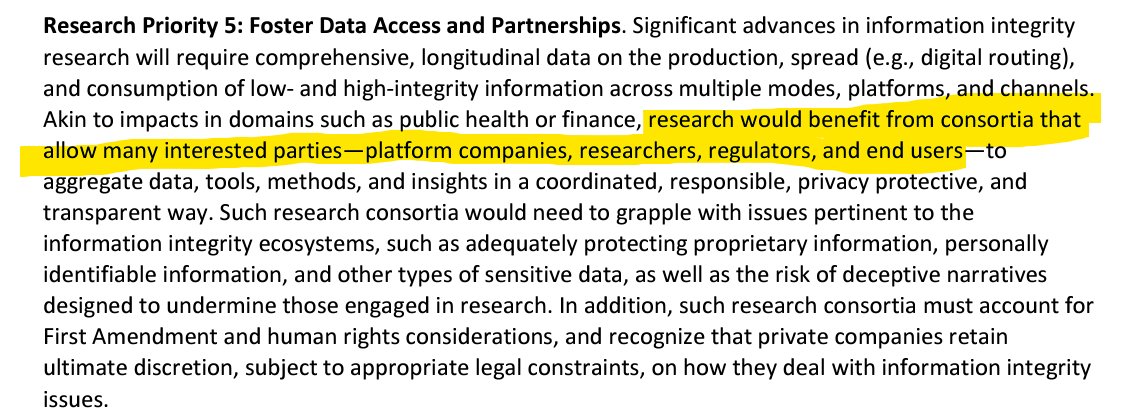
Against the Marketplace of Ideas
An intrinsic belief to supporters of free speech is the “marketplace of ideas” – the concept that First Amendment protected, uncensored free speech leads to healthy debate that allows for fair competition of differing viewpoints and ideas.
For the censors, the “marketplace of ideas” is problematic, because in recent years it has resulted in their ideological side losing public debates.
To show the government censors’ disdain for “the marketplace of ideas,” the following excerpt from the House Foreign Affairs Committee’s press release regarding their investigation of the State Department’s censorship bureau, the Global Engagement Center (GEC), is particularly illustrative:
“In 2019, Richard Stengel, the very first head of the GEC after its 2016 founding, published an op-ed in the Washington Post calling for an effective end to the First Amendment. This fact calls into question not only the founder, but the founding vision of the GEC itself. Stengel went on to say in a televised interview: ‘[T]he basis of the First Amendment, the marketplace of ideas model, is actually not working. Marketplace of ideas is this notion that good ideas will drive out bad ideas. Well, it was kind of a mystical notion coming from Milton and John Stewart Mill and that doesn’t really happen anymore … I’m actually very sympathetic now to the U.S. adopting some versions of hate speech laws in Europe.’ “
The White House’s censorship planning report hints at a disdain for free-flowing exchange of ideas, the same line of thinking espoused by government censorship agency chief Richard Stengel in years prior.
One of the “desired outcomes” of the government’s plans under the IIRD Roadmap is a “well functioning marketplace of ideas.” In their own report, our federal government calls the “marketplace of ideas” an “aspirational concept” and “idealized notion.”
Furthermore, they wanted to develop “new mechanisms [to] support high-integrity outcomes within the marketplace of ideas.” In other words, the government does not believe that organic, plain old free speech will lead to “high-integrity outcomes” – therefore free speech must not be allowed to run its course unchecked. In the government’s view, their preferred outcomes of ideological debate must be engineered.
Below is the full quote, taken directly from the December 2022 White House document:
The “marketplace of ideas” is an enduring sociopolitical concept that free and unfettered communication and exchange of ideas is emancipatory and essential for well-functioning democracies. This aspirational concept borrows from free market theories and is an idealized notion that the competition of ideas will result in the accurate and high-integrity ideas gaining acceptance and the low integrity alternatives being rejected. The claim that free exchange will converge on high-integrity outcomes continues to be a topic of debate. Nonetheless, the salient ideas, that all points of view should be afforded an opportunity to be heard and that free speech is essential in the development of informed choice, should be protected. Correspondingly, new mechanisms are needed to support high-integrity outcomes within the marketplace of ideas, while protecting both First Amendment and human rights.”
While hearing it from the White House may striking, it is not surprising, considering some of the most notorious nongovernmental censors have made similar chilling sentiments.
An FFO report published in December 2023 centered around a panel discussion featuring Kate Starbird and Francis Fukuyama, key censorship industry figures at the University of Washington and Stanford’s censorship centers (which as a reminder, are both listed as contributing universities in the White House’s official government censorship working group report).
Starbird remarked that freedom of speech was an idea that should not be “centered” because a “[level] playing field is tilted in favor of misinformation.”
Fukuyama (of “End Of History” fame), agreed with her comments and characterized “freedom of speech” and “the marketplace of ideas” as outdated “18th-century notions.”
“Trust in Institutions”
The government frames its goals in many different ways throughout the roadmap document. Improving “information integrity,” and “providing the public with high-integrity information” are examples of catchphrases used to describe their goals — no actor in the censorship industry ever outright describes their goals or methods as censorship.
One key goal the government identifies is restoring “trust in institutions.” Instead of considering the legitimate reasons why the public may be losing trust in institutions such as the press, government, and academia, and potential reforms to address those concerns, the working group concludes that insufficient suppression of “disinformation” is to blame.
So too is its reverse: insufficient amplification of establishment-approved information sources. On page 16 of its report, the working group calls for new “techniques” to “reestablish trust with national institutions.”
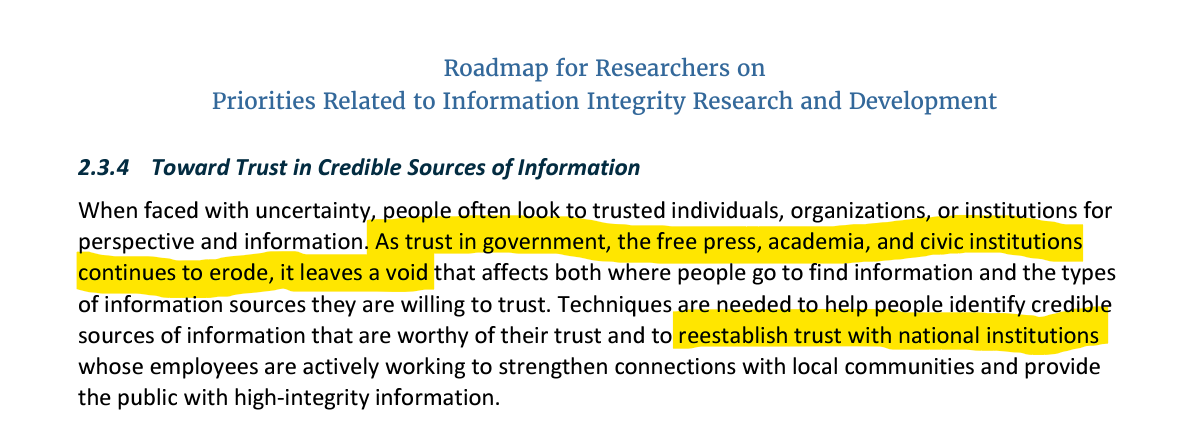
A Familiar Cast of Characters
The agencies, offices, universities, nonprofits, commercial enterprises, and individuals involved with the White House’s whole-of-society efforts are familiar names in the censorship industry. They include:
- NewsGuard
- Universities and agencies involved in The Virality Project / Election Integrity Partnership
- Katie Harbath / Anchor Change
The co-chairs of the working group (which were scrubbed off the internet during the drafting of this article), happen to be program managers from the government’s most notorious funding arms when it comes to internet censorship – one from the National Science Foundation (NSF) and the other from the Defense Advanced Research Projects Agency (DARPA).
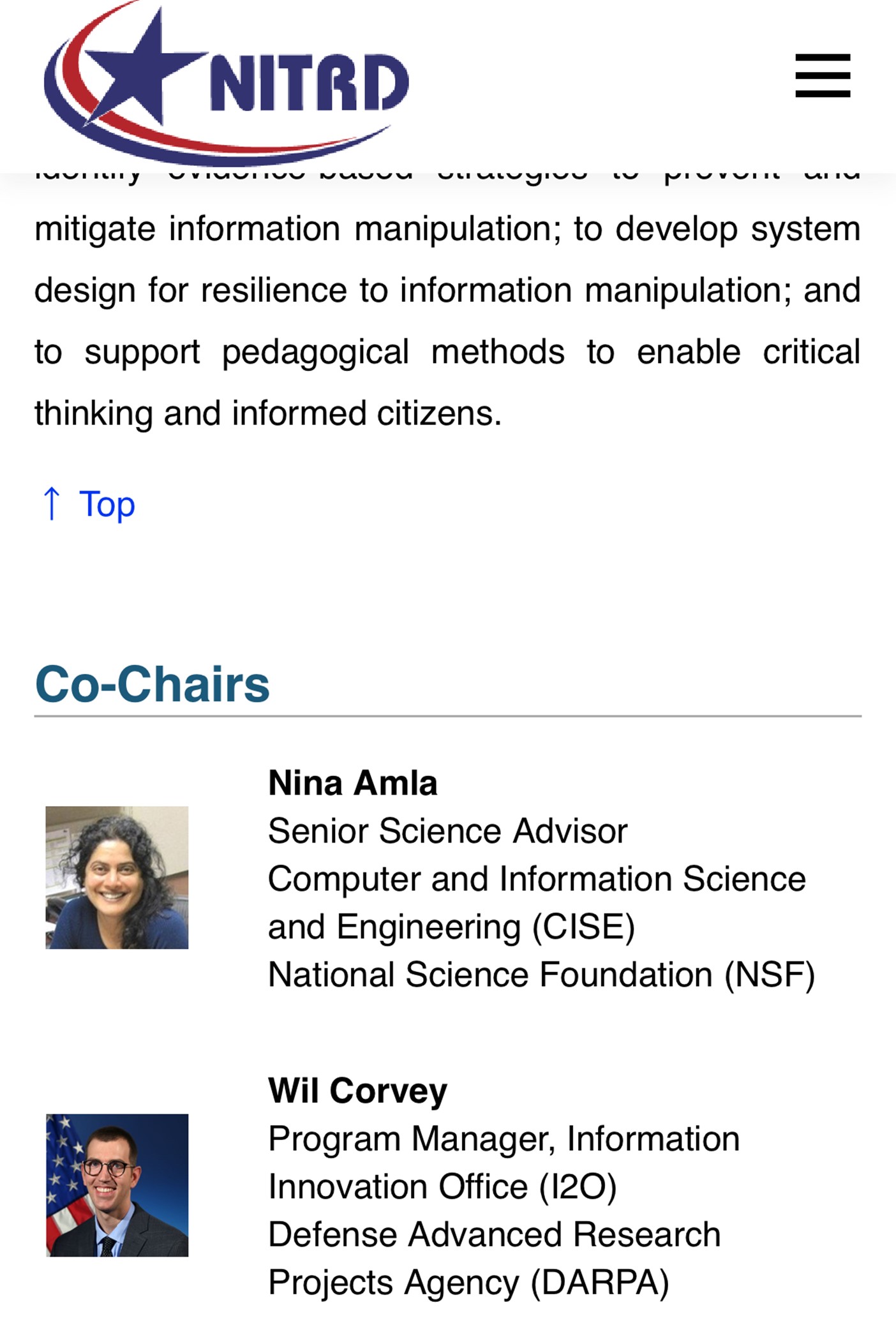
The DARPA and the NSF pairing is notable considering both have functioned similarly in funding university labs and notorious private censorship tech firms. They have done so to the tune of millions of dollars to develop new technologies and frameworks to identify, flag, and remove or mitigate disfavored speech online.
The NSF, for example, issued at least 64 government censorship grants, spread across 42 different colleges and universities The grants included funding of nonprofit Meedan, known for its technology to censor private messaging apps.
DARPA partnered with the infamous censorship tech firm Graphika, which began monitoring COVID-19 narratives weeks before the WHO knew COVID-19 even existed.
The previous administration’s public health components listed in the “information integrity” effort include the NIH, CDC, Office of Surgeon General, and FDA – the same public health agencies that are heavily associated with combating Covid-19 lockdown and vaccine skepticism.
CDC and the Office of Surgeon General were mentioned as direct partners of the Virality Project (VP), a consortium of NGOs and universities that worked to censor COVID-19 claims.
The end goal of the Virality Project was to make “policy recommendations for academics, public health experts, government entities, and tech platforms with the goal of engendering a whole-of-society effort to address health misinformation.”
Below is a Mapping of the Virality Project’s workflow, from their own final report:
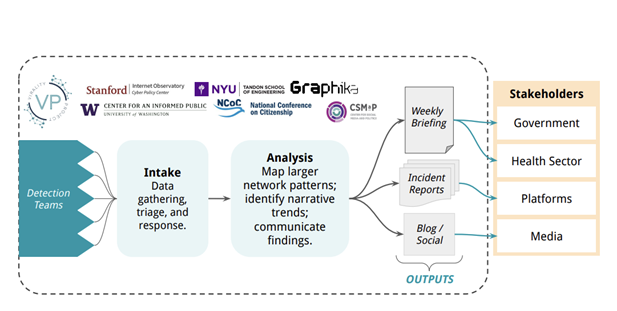
Censorship tech firm Graphika is also seen above as a partner of VP.
From 2020 to the present day, Graphika has received at least 13 contracts and three grants to do work for the Office of Naval Research and the Air Force Office of Scientific Research. These two Department of Defense offices were specifically named amongst the 26 federal government components that contributed to the White House working group. Four of these DoD-funded Graphika projects are listed as currently ongoing.
The bulk of Graphika’s funding comes around recent presidential election seasons. The total award amount has been at least $14.5 million from the Air Force and Naval research offices, with nearly half of their total publicly listed government funding ($6.3 million in FY 2024 alone), ahead of the presidential elections.
Another $5 million of their funding came in FY 2021 (October 1, 2020 to September 30, 2021), during and after their involvement in censoring the 2020 elections and during the time they helped to censor COVID-19 narratives.
The Virality Project was set up by the organizations that formed 2020’s Election Integrity Partnership: The Stanford Internet Observatory, the University of Washington’s Center for an Informed Public, Graphika, and the Atlantic Council (which has 7 former CIA directors as board members and receives funding from the State Department, DoD and other government agencies). Incubated by DHS, the Election Integrity Partnership led efforts to censor the 2020 election.
Another partner mentioned in the White House working group’s report is NewsGuard, arguably the most influential private sector censorship provider. NewsGuard builds blacklists of disfavored news websites, telling users which sites to trust and distrust through a browser plug-in. The company also sells these blacklists to large advertising firms to cut off revenue from disfavored websites.
NewsGuard is partnered with the public school teacher’s union to supplement “media literacy” education, and have additionally worked with the European Union to advise on and participate in the strengthening of their censorship policy initiatives.
The White House also lists Anchor Change as a contributor to the document, which is censorship industry insider Kate Harbath’s consulting outfit.
Harbath is involved in several censorship-affiliated organizations. She is a tech fellow at the International Republican Institute (IRI), a core institute of the National Endowment for Democracy (NED). NED performs CIA-like regime change functions and has recently been given blanket agreements by the State Department to hide their activities from the public, even though their funding comes entirely from the federal government.
Harbath also is a fellow at the Atlantic Council’s DFR Lab, a notorious global censorship entity that helped Stanford, UW, and Graphika censor the 2020 elections.
She additionally is Chair of the Board at the National Conference on Citizenship (NCoC), a congressionally-chartered nonprofit that was also involved in the Election Integrity Partnership/VP censorship consortia. NCoC has redirected its focus in recent years to censorship, including its “Junkipedia” database of alleged disinformation, and devising ways to monitor and censor people’s private text messages on platforms like WhatsApp.
Media Literacy Education
The phrases “media literacy,” “information literacy,” “digital literacy” and “news literacy” are collectively mentioned in the White House working group’s roadmap more than thirty times. As previous FFO reports have exposed, these “literacy” efforts are the censorship industry’s chief method of smuggling pro-censorship, ideologically biased material into schools.

The DHS has notably been involved in efforts to push overtly biased censorship into schools via the “media literacy” route, inserting censorious media literacy materials into schools through an anti-terrorism grant program.
Media literacy education has been mandated in several states. In practice, initiatives like NewsGuard and Newsela, which are marketed as “media literacy” education tools, tell students which news sources to avoid and which they ought to trust.
The tendency of organizations like NewsGuard has been to promote legacy media sources like the Washington Post, New York Times, and Wall Street Journal (where NewsGuard’s founders hail from) while discrediting non-establishment sources.
Supporting International Censorship Mandates
A key focus of the censorship industry in recent years has been on supporting international measures like the EU Digital Services Act (DSA), that aim to punish American tech platforms for not complying with demands to act against speech they deem to be hateful, or for not doing enough to curb so-called mis- or dis- information.
Such legal predicates may cause platforms to remove speech from Americans on those platforms to avoid financial throttling and platform bans at the hands of foreign governments. In Brazil, Elon Musk’s noncompliance with censorship demands for example, led to them banning the platform.
The White House’s censorship roadmap guidebook focuses on involving international organizations in the effort.
On page 1, the effort is immediately framed as not making legal or policy recommendations, just stimulating mere “research”:
“Importantly, the Roadmap is not a policy directive. It does not make any recommendations regarding laws. It also does not include any requirements or regulations. Instead, its purpose is to stimulate research that can be used to strengthen the role of information ecosystems in the open exchange of ideas where healthy debate and free expression thrive.”
But even the roadmap document itself, which is framed as providing inconspicuous “research” suggestions, specifically states that a partnership with the EU should be assessed.
A particular focus with international partners, said the federal government, should be to provide U.S. researchers with “access to social media data” by leveraging the 2022 EU Code of Practice on Disinformation:
“5.2.3.4 Engagements with International Partners. Expand on existing efforts, exchange lessons learned, and further establish joint research and pilot programs with researchers and entities outside the United States. Expand partnerships that enable development of information integrity tools for low-resource languages and assessment of manipulated-information campaigns in parts of the world where research has traditionally been sparse. Assess establishing a partnership with the European Union (EU) to provide U.S. researchers with access to social media data accessible under the 2022 EU Code of Practice on Disinformation.”
American censors have viewed the DSA as a lifeline for continuing the ability to suppress speech on platforms, especially in the case of Twitter (now X) under Elon Musk’s anti-censorship leadership.
The 2022 EU Code of Practice on Disinformation, which is technically voluntary, is currently in the process of being encoded to become an official set of rules for platforms to follow as part of the DSA.
The previously mentioned censorship industry insider whose consulting firm is mentioned in the White House roadmap, Kate Harbath, is additionally a fellow at the Integrity Institute, another contributing organization listed in the White House roadmap.
The Integrity Institute’s involvement is interesting given that they are formal partners with the EU in their legal efforts to promote internet censorship.
The Institute was selected as subcontractor to the European Commission in December 2022, to consult in the EU-led efforts to develop “counter-disinformation” practices, specifically providing advice to strengthen the 2022 Code of Practice on Disinformation.
Kate Harbath herself was sent to give testimony to the UK parliament in April 2023 to talk about the state of the censorship industry and solutions. In her appearance before parliament, she made the case that mechanisms for coordination of data sharing to American censors could be funneled through European censorship laws.
At this point, the American censorship industry had largely been caught red-handed in their censorship work that reached a height in 2020-2021 (hence her below mention of “a chilling effect” on their field of work)..
In addition, as my fellow witnesses mentioned, particularly here in the United States, the researchers and those who study this environment have been attacked politically. They have been brought in front of congressional hearings; they have been buried under freedom of information requests. This has had a chilling effect on the work to even understand what is happening. On top of that, the platforms have pulled back some of the access to data in order to understand what is happening on those platforms. Legislation such as the Online Safety Act and the Digital Services Act in the EU will potentially change that, but that remains a challenge for many of these folks.”
Harbath’s testimony came as platforms under increasing public pressure, scaled back efforts that previously allowed censors access to data and direct lines of communications with their trust and safety departments. Harbath’s above mention specifically mentioned the DSA as the international policy loophole that would allow herself and others to regain the ability to more directly monitor platforms again.
While little outside of the roadmap report has been published to the public regarding the work the White House working group on information integrity since 2022, it remains an ongoing effort. In a December 2024 report, the President’s Council of Advisors on Science and Technology lists it as one of the 11 ongoing Interagency Working Groups of the Networking and Information Technology Research and Development Program.

